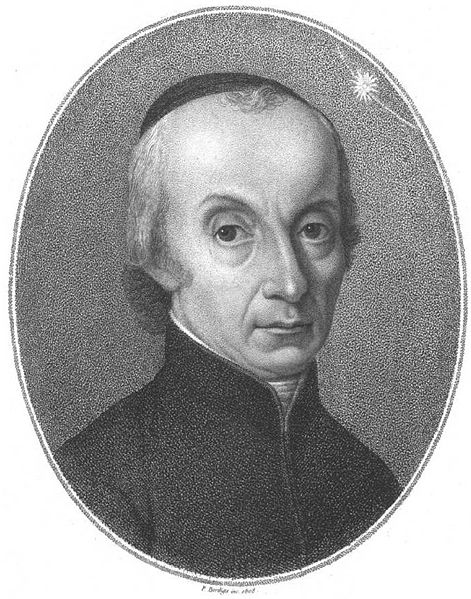<Back to Index>
- Astronomer Giuseppe Piazzi, 1746
- Sculptor Joseph Wilton, 1722
- President of the Continental Congress Samuel Huntington, 1731
PAGE SPONSOR

Giuseppe Piazzi (July 16, 1746 - July 22, 1826) was an Italian Catholic priest of the Theatine order, mathematician, and astronomer. He was born in Ponte in Valtellina, and died in Naples. He established an observatory at Palermo, now the Osservatorio Astronomico di Palermo – Giuseppe S. Vaiana.
No documented account of Piazzi's scientific education is available in any of the biographies of the astronomer, even in the oldest ones. Piazzi certainly did some studies in Torino, quite likely attending Giovan Battista Beccaria's lessons. In the years 1768 - 1770 he was resident at the Theatines' Home in S. Andrea della Valle, Rome, while studying Mathematics under Jd.
In July 1770 he took the chair of Mathematics at the University of Malta. In December 1773 he moved to Ravenna as "prefetto degli studenti" and lecturer in Philosophy and Mathematics at the Collegio dei Nobili, where he stayed until the beginning of 1779. After a short period spent in Cremona and in Rome, in March 1781 Piazzi moved to Palermo as lecturer in Mathematics at the University of Palermo (at the time known as "Accademia de' Regj Studi").
He kept this position until 19 January 1787, when he became Professor of Astronomy. Almost at the same time he was granted permission to spend two years in Paris and London in order to undergo some practical training in astronomy and also to get some instruments to be specially built for the Palermo Observatory, whose foundation he was in charge of.
In the period spent abroad, from 13 March 1787 until the end of 1789, Piazzi became acquainted with the major French and English astronomers of his time and was able to have the famous altazimuthal circle made by Jesse Ramsden, one of the most skilled instrument makers of 18th century. The circle was the most important instrument of the Palermo Observatory, whose official foundation took place on 1 July 1790.
In 1817 King Ferdinand put
Piazzi in charge of the completion of the Capodimonte (Napoli)
Observatory, naming him General Director of the Naples and Sicily
Observatories. He supervised the compilation of the Palermo Catalogue of stars, containing 7,646 star entries with unprecedented precision, including the star names "Garnet Star" from Herschel, and the original Rotanev and Sualocin.
The work on this catalogue was started in 1789, enabling Piazzi and
collaborators to observe the sky methodically. The catalogue wasn't
finished for the first edition publication until 1803. Spurred
by the success discovering Ceres, and along the line of his
catalogue program, Piazzi studied the proper motions of stars in order
to find parallax measurement candidates. One of them, 61 Cygni, was specially appointed as a good candidate for measuring a parallax, which was later performed by Friedrich Wilhelm Bessel. The star system 61 Cygni is sometimes still called variously Piazzi's Flying Star and Bessel's Star. Piazzi discovered Ceres, today known as the largest member of the asteroid belt. On January 1, 1801, Piazzi discovered a "stellar object" that moved against the background of stars.
At first he thought it was a fixed star, but once he noticed that it
moved, he became convinced it was a planet, or as he called it, "a new
star". In his journal, he wrote: "The light was a little faint, and of the colour of Jupiter, but similar to many others which generally are reckoned of the eighth magnitude.
Therefore I had no doubt of its being any other than a fixed star. In
the evening of the second I repeated my observations, and having found
that it did not correspond either in time or in distance from the
zenith with the former observation, I began to entertain some doubts of
its accuracy. I conceived afterwards a great suspicion that it might be
a new star. The evening of the third, my suspicion was converted into
certainty, being assured it was not a fixed star. Nevertheless before I
made it known, I waited till the evening of the fourth, when I had the
satisfaction to see it had moved at the same rate as on the preceding
days." In spite of his assumption that it was a planet, he took the conservative route and announced it as a comet. In a letter to astronomer Barnaba Oriani of Milano he made his suspicions known in writing: He was not able to observe it long enough as it was soon lost in the glare of the Sun. Unable to compute its orbit with existing methods, the renowned mathematician Carl Friedrich Gauss developed
a new method of orbit calculation that allowed astronomers to locate it
again. After its orbit was better determined, it was clear that
Piazzi's assumption was correct and this object was not a comet but
more like a small planet. Coincidentally, it was also almost exactly where the Titius - Bode law predicted a planet would be. Piazzi named it "Ceres Ferdinandea," after the Roman and Sicilian goddess of grain and King Ferdinand IV of Naples and Sicily. The Ferdinandea part was later dropped for political reasons. Ceres turned out to be the first, and largest, of the asteroids existing within the Asteroid Belt. Ceres is today called a dwarf planet.
In 1871, a memorial statue of Piazzi sculpted by Costantino Corti was dedicated in the main plaza of his birthplace, Ponte. In 1923, the 1000th asteroid to be numbered was named 1000 Piazzia in his honor. The lunar crater Piazzi was named after him in 1935. More recently, a large albedo feature, probably a crater, imaged by the Hubble Space Telescope on Ceres, has been informally named Piazzi.